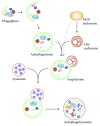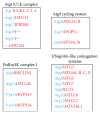Autophagy: New Questions from Recent Answers
- PMID: 27335669
- PMCID: PMC4890908
- DOI: 10.5402/2012/738718
Autophagy: New Questions from Recent Answers
Abstract
Macroautophagy (hereafter autophagy) is currently one of the areas of medical life sciences attracting a great interest because of its pathological implications and therapy potentials. The discovery of the autophagy-related genes (ATGs) has been the key event in this research field because their study has led to the acquisition of new knowledge about the mechanism of this transport pathway. In addition, the investigation of these genes in numerous model systems has revealed the central role that autophagy plays in maintaining the cell homeostasis. This process carries out numerous physiological functions, some of which were unpredicted and thus surprising. Here, we will review some of the questions about the mechanism and function of autophagy that still remain unanswered, and new ones that have emerged from the recent discoveries.
Figures


Similar articles
-
Roles of Autophagy-Related Genes in the Pathogenesis of Inflammatory Bowel Disease.Cells. 2019 Jan 21;8(1):77. doi: 10.3390/cells8010077. Cells. 2019. PMID: 30669622 Free PMC article. Review.
-
An overview of macroautophagy in yeast.J Mol Biol. 2016 May 8;428(9 Pt A):1681-99. doi: 10.1016/j.jmb.2016.02.021. Epub 2016 Feb 22. J Mol Biol. 2016. PMID: 26908221 Free PMC article. Review.
-
Molecular Mechanisms of Noncanonical Autophagy.Int Rev Cell Mol Biol. 2017;328:1-23. doi: 10.1016/bs.ircmb.2016.08.001. Epub 2016 Sep 28. Int Rev Cell Mol Biol. 2017. PMID: 28069131 Review.
-
Genetic aberrations in macroautophagy genes leading to diseases.Biochim Biophys Acta Mol Cell Res. 2018 May;1865(5):803-816. doi: 10.1016/j.bbamcr.2018.03.002. Epub 2018 Mar 8. Biochim Biophys Acta Mol Cell Res. 2018. PMID: 29524522 Review.
-
MicroRNA regulation of autophagy.Carcinogenesis. 2012 Nov;33(11):2018-25. doi: 10.1093/carcin/bgs266. Epub 2012 Aug 17. Carcinogenesis. 2012. PMID: 22902544 Review.
Cited by
-
Intricate relationships between naked viruses and extracellular vesicles in the crosstalk between pathogen and host.Semin Immunopathol. 2018 Sep;40(5):491-504. doi: 10.1007/s00281-018-0678-9. Epub 2018 May 22. Semin Immunopathol. 2018. PMID: 29789863 Free PMC article. Review.
-
AI-based AlphaFold2 significantly expands the structural space of the autophagy pathway.Autophagy. 2023 Dec;19(12):3201-3220. doi: 10.1080/15548627.2023.2238578. Epub 2023 Jul 30. Autophagy. 2023. PMID: 37516933 Free PMC article.
-
Autophagy Regulatory Network - a systems-level bioinformatics resource for studying the mechanism and regulation of autophagy.Autophagy. 2015;11(1):155-65. doi: 10.4161/15548627.2014.994346. Autophagy. 2015. PMID: 25635527 Free PMC article.
-
Recent Advances in Our Understanding of Age-Related Macular Degeneration: Mitochondrial Dysfunction, Redox Signaling, and the Complement System.Aging Dis. 2024 Jan 24;16(3):1535-1575. doi: 10.14336/AD.2024.0124. Aging Dis. 2024. PMID: 38421830 Free PMC article. Review.
-
Mitochondrial quality control in AMD: does mitophagy play a pivotal role?Cell Mol Life Sci. 2018 Aug;75(16):2991-3008. doi: 10.1007/s00018-018-2843-7. Epub 2018 May 18. Cell Mol Life Sci. 2018. PMID: 29777261 Free PMC article. Review.
References
-
- Mizushima N., Yoshimori T., Ohsumi Y. The role of Atg proteins in autophagosome formation. Annual Review of Cell and Developmental Biology. 2011;27:107–132. - PubMed
Publication types
LinkOut - more resources
Full Text Sources
